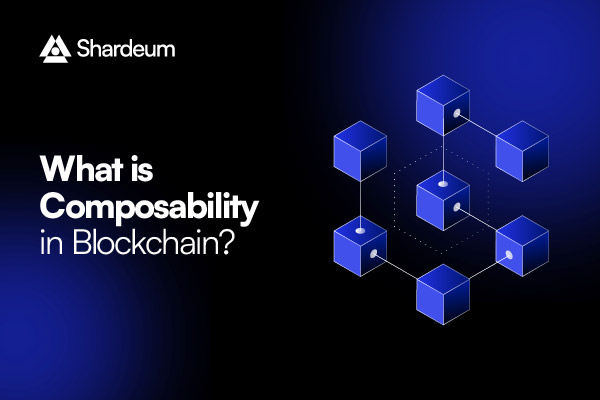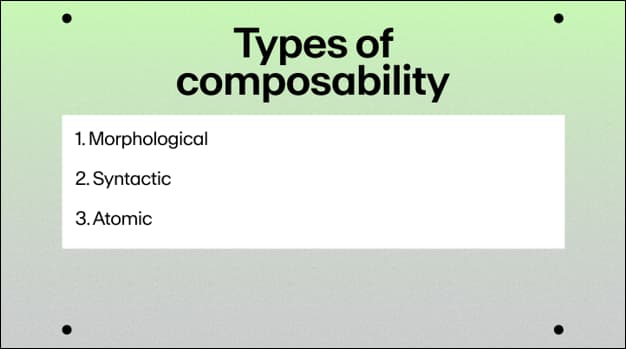
Composability in Blockchain – Types, Importance and Risk
Composability in blockchain refers to the ability of smart contracts and protocols to seamlessly integrate and interact, enabling new decentralized applications and...

Composability in blockchain refers to the ability of smart contracts and protocols to seamlessly integrate and interact, enabling new decentralized applications and...
Composability in blockchain refers to the capability of combining and interconnecting different blockchain protocols, smart contracts, and decentralized applications (dapps) in a modular and interoperable manner. It allows developers to leverage existing building blocks and protocols to create new applications and services without starting from scratch.
Composability enables the seamless integration of various functionalities, such as token transfers, decentralized finance (DeFi) protocols, or decentralized exchanges (DEXs), to build more sophisticated and innovative solutions. However, ensuring security, proper auditing, and managing complex dependencies are crucial considerations when utilizing composability in blockchain to mitigate potential risks.

Blockchain’s composability works by leveraging open standards, protocols, and smart contracts to enable the modular combination of different components. Smart contracts, self-executing contracts written in code, are the building blocks that can be deployed on a blockchain. These smart contracts can interact with each other, creating a network of interconnected functionality. Developers can utilize existing smart contracts, protocols, or decentralized applications (dapps) and combine them to create new applications or services. This modularity allows for rapid innovation and the creation of complex decentralized systems by mixing and matching various components to achieve desired functionalities and outcomes.

There are different types of composability in blockchain, each serving a specific purpose.
Morphological composability in blockchain combines basic elements or functionalities to create more complex systems. It involves the stacking together of different smart contracts, protocols, or decentralized applications (dapps) like building blocks to achieve desired outcomes. Developers can combine existing components to create innovative applications or services.
Morphological composability enables the modular construction of blockchain systems by breaking down complex functionalities into smaller, reusable components. These components can be easily interconnected and combined to create new and customized applications. This type of composability promotes flexibility, scalability, and rapid innovation in the blockchain ecosystem.
Syntactic composability in blockchain focuses on the compatibility and interoperability between smart contracts or protocols. It ensures that the interfaces and communication methods between components are standardized and can seamlessly interact with one another.
Syntactic composability allows for the smooth integration of various modules, enhancing the overall functionality and efficiency of the composed system.
By adhering to common standards and protocols, syntactic composability enables different components to work together without conflicts or inconsistencies. It facilitates the exchange of information, assets, or transactions between smart contracts or dapps, promoting interoperability and creating more complex and interconnected blockchain applications.
Atomic composability in blockchain refers to breaking down complex functionalities into smaller, independent, and self-contained components called atoms. These atomic units can be combined, mixed, and matched with other atoms to create more complex systems. Each atom performs a specific function and can be reused across different applications, promoting modularity and flexibility.
With atomic composability, developers can create a library of atomic components that can be easily combined to build diverse and customized applications. These components can be considered “Lego blocks” stacked together in various ways, creating novel and highly customizable blockchain solutions.
Atomic composability enhances code reusability, simplifies development, and encourages collaboration within the blockchain community while preserving the consistency of a blockchain.
Let’s explore ‘why is composability important in blockchain?’, next. Here are several reasons:
Composability accelerates development by allowing developers to leverage existing building blocks and protocols. It eradicates the need to start from scratch, enabling rapid innovation and reducing development time and effort. Also, it can combine and reconfigure these building blocks to create new applications, saving time and effort compared to building everything from scratch.
Composability enables developers to focus on solving new problems rather than reinventing the wheel. Combining existing components can create novel applications and services that address specific use cases or cater to unique requirements.
By leveraging pre-existing building blocks and protocols, developers can combine and integrate them innovatively to address specific use cases or cater to unique requirements.
Composability fosters interoperability, enabling seamless integrations between different protocols and smart contracts. It facilitates the creation of complex systems by combining functionalities from multiple sources, expanding the possibilities and capabilities of blockchain applications.

While composability offers significant advantages, it also presents certain risks in the blockchain ecosystem:
Composability relies on the underlying blockchain infrastructure. If the base layer experiences a security breach or suffers from scalability issues, it can impact the entire composed system, potentially leading to disruptions and vulnerabilities. This failure can have far-reaching consequences, potentially impacting the blockchain’s:
Smart contract failures refer to instances where smart contracts do not behave as intended or contain vulnerabilities that can be exploited. These failures can lead to undesirable consequences such as:
Some of the reasons for smart contract failures include coding errors, logic flaws, or design weaknesses.
Composability increases the complexity of security considerations. “Compound security” typically refers to the security measures and considerations implemented within protocols like Compound to protect user funds and ensure the platform’s integrity. Interactions between different protocols and smart contracts can create new attack vectors, requiring detailed auditing and rigorous security measures to avoid vulnerabilities in the composed system.
Composability introduces complexity in understanding the behavior and dependencies between different components. The interconnected nature of composed systems can make it challenging to identify and address potential issues, requiring careful testing and analysis to ensure the reliability and stability of the overall system.
Composability is a powerful concept in blockchain that enables developers to combine and integrate different protocols, smart contracts, and decentralized applications to create innovative and complex systems. It promotes rapid development, as existing building blocks can be reused, reducing time and effort.
However, composability is not without risks. Base layer failures, smart contract vulnerabilities, compound security challenges, and increased complexity are factors that must be carefully managed. Ensuring robust security measures, thorough audits, and diligent testing are crucial to mitigate these risks. By understanding and addressing the risks, composability can continue to drive the advancement and adoption of blockchain technology, unlocking its full potential for innovation and decentralized applications.
An example of composability in crypto is the combination of decentralized finance (DeFi) protocols to create more advanced financial applications. For instance, developers can use lending protocols, liquidity pools, and automated market makers (AMMs) to build innovative applications such as yield farming, decentralized lending, or decentralized exchanges (DEXs).
Composability of DeFi protocols refers to the ability to integrate and interact with different DeFi protocols seamlessly. It allows developers to combine protocols like Lego blocks to create novel financial applications. By leveraging the composability of DeFi protocols, developers can create sophisticated decentralized systems that offer a wide range of financial services and functionalities.
Composability in Web3 refers to the interoperability and integration of various Web3 technologies, including blockchain, decentralized applications (dapps), and decentralized protocols. It enables developers to combine different components to create interconnected systems and services. Composability in Web3 promotes the modular construction of applications and fosters collaboration and innovation in the decentralized web ecosystem.
Decentralized Social Media | Difference Between Cryptocurrency and Blockchain | Best Crypto Faucets | Physical Layer in OSI Model | Advantages and Disadvantages of Decentralization | Ordinals NFTs | What are EVM Compatible Blockchains | Best Decentralized Storage Networks | What is Consortium Blockchain | Layer 1 Blockchain | Top Crypto Influencers | What is EVM Wallet | Blockchain Validator | Blockchain API | Web3 Events | Node.js | Truffle Suite | POAP | EIP and ERC | Remix IDE | Github Vs Gitlab | 51% Attack | Throughput Vs Bandwidth | Solidity Interfaces